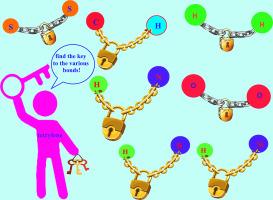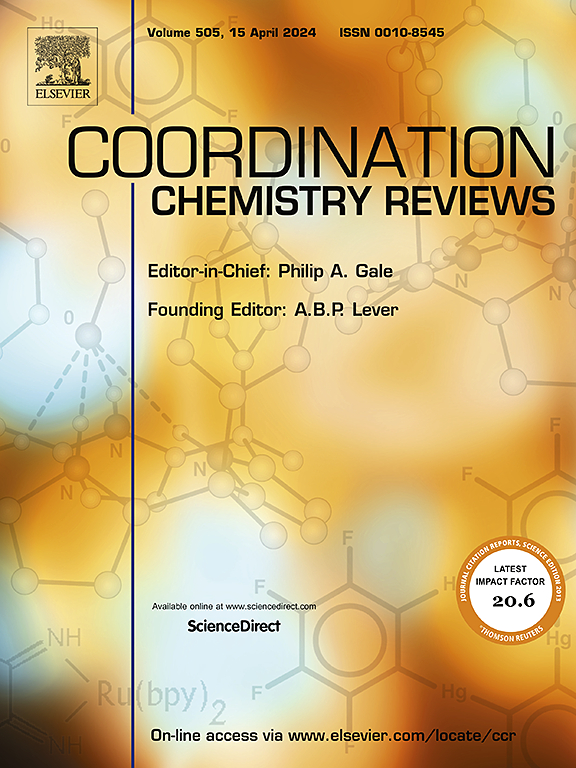Oxidative addition reactions of heavy analogs of carbenes (germylenes, stannylenes, plumbylenes) to σ-bonds
IF 20.3
1区 化学
Q1 CHEMISTRY, INORGANIC & NUCLEAR
引用次数: 0
Abstract
Oxidative addition reactions are the key stage of catalytic transformations. This review presents a detailed discussion of the oxidative addition reactions of low-valent group 14 derivatives (Ge, Sn, Pb) to various sigma bonds, including H H, C
H, C H, H-Hal, H
H, H-Hal, H N, H
N, H Si, H
Si, H B, Hal-Hal, P-Hal, P
B, Hal-Hal, P-Hal, P P, S
P, S S, O
S, O O. Furthermore, the features of oxidative addition reactions of tetrylenes with diverse substituents (C-, O-, N-, S-, B-bonded) are discussed from the viewpoint of relation to bond angles and HOMO-LUMO gaps. The direction and rates of oxidative addition reactions of tetrylenes strongly depend on the tetrel atom, as well as the presence of donor-acceptor interactions in tetrylene, the oligomeric state and bond angle values around the tetrel atom, and the value of the HOMO-LUMO gap. In general, the Ge(II) derivatives tend to form Ge(IV) oxidative addition products, the Sn(II) analogues often form Sn(II) bridging products; while the Pb(II) derivatives are less stable and prone to disproportionation reactions. The reactivity of C-substituted tetrylenes is influenced by the bond angle values and the HOMO-LUMO gap. The latter can be reduced by replacing one of the C-containing substituents with donor fragments. The reactivity of heteroleptic tetrylenes with acceptor substituents is reduced in oxidative addition reactions. The presence of intramolecular interactions between the tetrel atom and the donor molecules or functional groups of ligands can also alter the direction of oxidative addition reactions. The primary factor affecting the oxidative addition reactions of O-substituted tetrylenes is the monomeric or oligomeric state. Tetrylenes based on redox-active catecholate or o-amidophenolate ligands undergo oxidation of the redox-active ligand in the presence of halogens or compounds with weak O
O. Furthermore, the features of oxidative addition reactions of tetrylenes with diverse substituents (C-, O-, N-, S-, B-bonded) are discussed from the viewpoint of relation to bond angles and HOMO-LUMO gaps. The direction and rates of oxidative addition reactions of tetrylenes strongly depend on the tetrel atom, as well as the presence of donor-acceptor interactions in tetrylene, the oligomeric state and bond angle values around the tetrel atom, and the value of the HOMO-LUMO gap. In general, the Ge(II) derivatives tend to form Ge(IV) oxidative addition products, the Sn(II) analogues often form Sn(II) bridging products; while the Pb(II) derivatives are less stable and prone to disproportionation reactions. The reactivity of C-substituted tetrylenes is influenced by the bond angle values and the HOMO-LUMO gap. The latter can be reduced by replacing one of the C-containing substituents with donor fragments. The reactivity of heteroleptic tetrylenes with acceptor substituents is reduced in oxidative addition reactions. The presence of intramolecular interactions between the tetrel atom and the donor molecules or functional groups of ligands can also alter the direction of oxidative addition reactions. The primary factor affecting the oxidative addition reactions of O-substituted tetrylenes is the monomeric or oligomeric state. Tetrylenes based on redox-active catecholate or o-amidophenolate ligands undergo oxidation of the redox-active ligand in the presence of halogens or compounds with weak O O bonds.
O bonds.

重碳烯类似物(锗烯、锡烯、钚烯)与σ键的氧化加成反应
本文章由计算机程序翻译,如有差异,请以英文原文为准。
求助全文
约1分钟内获得全文
求助全文
来源期刊

Coordination Chemistry Reviews
化学-无机化学与核化学
CiteScore
34.30
自引率
5.30%
发文量
457
审稿时长
54 days
期刊介绍:
Coordination Chemistry Reviews offers rapid publication of review articles on current and significant topics in coordination chemistry, encompassing organometallic, supramolecular, theoretical, and bioinorganic chemistry. It also covers catalysis, materials chemistry, and metal-organic frameworks from a coordination chemistry perspective. Reviews summarize recent developments or discuss specific techniques, welcoming contributions from both established and emerging researchers.
The journal releases special issues on timely subjects, including those featuring contributions from specific regions or conferences. Occasional full-length book articles are also featured. Additionally, special volumes cover annual reviews of main group chemistry, transition metal group chemistry, and organometallic chemistry. These comprehensive reviews are vital resources for those engaged in coordination chemistry, further establishing Coordination Chemistry Reviews as a hub for insightful surveys in inorganic and physical inorganic chemistry.
 求助内容:
求助内容: 应助结果提醒方式:
应助结果提醒方式:


